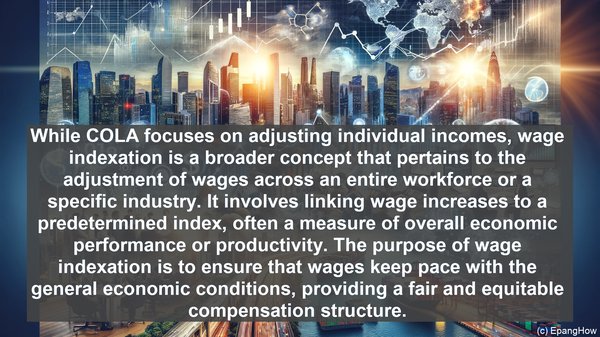Introduction: The Dynamics of Income
Hello everyone, welcome to our article on the intriguing world of income dynamics. Today, we’ll be delving into the realms of cost of living adjustment and wage indexation, two crucial concepts that often shape the financial landscape. Let’s get started!

Defining Cost of Living Adjustment
Cost of Living Adjustment, commonly referred to as COLA, is a mechanism used to adjust salaries, wages, or benefits to account for changes in the cost of living. It ensures that an individual’s purchasing power remains relatively stable over time, considering the fluctuations in prices of essential goods and services. COLA is typically tied to a specific index, such as the Consumer Price Index (CPI), which tracks the average price changes of a basket of goods and services.
The Purpose and Significance of COLA
The primary purpose of COLA is to address the impact of inflation. Inflation refers to the general increase in prices, which erodes the value of money. Without a COLA mechanism, individuals’ incomes would effectively decrease in real terms over time. COLA ensures that employees, retirees, or individuals receiving benefits experience a commensurate increase in their income, thus maintaining their standard of living. It acts as a safeguard against the rising cost of essential items like housing, healthcare, and groceries.
Understanding Wage Indexation
While COLA focuses on adjusting individual incomes, wage indexation is a broader concept that pertains to the adjustment of wages across an entire workforce or a specific industry. It involves linking wage increases to a predetermined index, often a measure of overall economic performance or productivity. The purpose of wage indexation is to ensure that wages keep pace with the general economic conditions, providing a fair and equitable compensation structure.
The Rationale Behind Wage Indexation
Wage indexation is primarily driven by the desire for wage stability and fairness. By tying wage increases to an index, such as the Gross Domestic Product (GDP) or the average wage growth, it eliminates the need for frequent negotiations or disputes over wage adjustments. It provides a transparent and predictable framework, benefiting both employers and employees. Additionally, wage indexation can act as an automatic stabilizer during economic downturns, as it ensures that wages do not plummet drastically, thus maintaining purchasing power and demand in the market.
Key Differences: COLA vs. Wage Indexation
While both COLA and wage indexation involve adjusting incomes, there are some fundamental differences. COLA is typically tied to a specific index, such as the CPI, which reflects the changes in the cost of living. On the other hand, wage indexation is often linked to broader economic indicators, such as GDP or productivity. Another key distinction is the scope of application. COLA is more individual-centric, focusing on adjusting the income of a specific person or group, while wage indexation has a wider impact, affecting the wages of an entire workforce or industry.

Flexibility and Adjustability
Another notable difference lies in the flexibility and adjustability of the two mechanisms. COLA adjustments are typically automatic and periodic, often occurring annually or semi-annually. They are based on the changes in the chosen index and do not require active intervention. In contrast, wage indexation may involve more deliberation and decision-making. The frequency and extent of wage adjustments can vary, depending on the economic conditions, collective bargaining agreements, or industry-specific factors.
Application in Different Contexts
The contexts in which COLA and wage indexation are applied also differ. COLA is commonly seen in the public sector, where it ensures that government employees or retirees receive fair and consistent adjustments to their income. It is also prevalent in pension plans, social security systems, or any scenario where a fixed income needs to keep up with the changing cost of living. Wage indexation, on the other hand, is often found in industries with strong labor unions or in countries with a tradition of collective bargaining. It serves as a mechanism to maintain wage parity and prevent income disparities.
